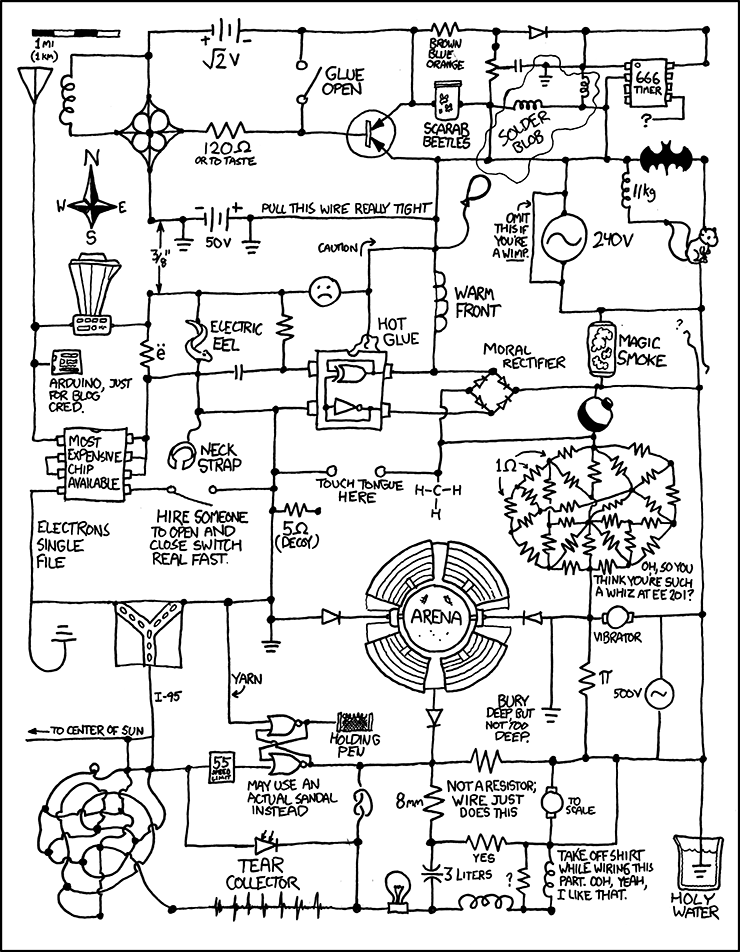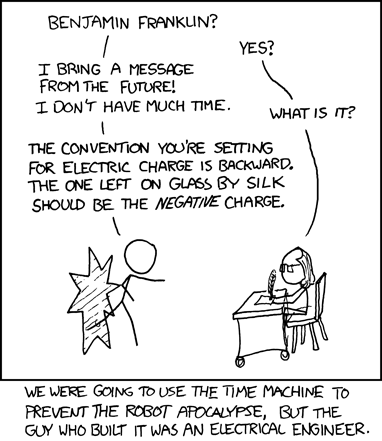I have a dc circuit that's not really complex but I need to figure out in detail why it is designed the way it is... who has a few minutes?!
Anyone here an electrical engineer?
- Thread starter wantafastz28
- Start date
You are using an out of date browser. It may not display this or other websites correctly.
You should upgrade or use an alternative browser.
You should upgrade or use an alternative browser.
nayr
IPCT Contributor
Fastb
Known around here
Rusty, but I'm an EE. My actual EE design was many years ago, but managed EE's and product development for decades....
Wotcha got?
Wotcha got?
tangent
IPCT Contributor
- May 12, 2016
- 4,641
- 3,996
looney2ns
IPCT Contributor
tigerwillow1
Known around here
Fastb
Known around here
First guess: 1.5 ohms.
Logic: There's two short paths of 3 ohms each. 3ohm in parallel is 1.5ohms.
Second guess: less than 1 ohm.
Logic: Considering the one vertical resistor between the two paths: There's 2 ohms in parallel to reach the last resistor in series. (2ohm in parallel = 1ohm). Then the series 1ohm resistor = two 2 ohm paths in parallel, totals 1 ohm from red dot to red dot.
Considering the infinite number of longer, higher resistance paths in parallel, that would reduce the 1ohm resistance a little bit.
Logic: There's two short paths of 3 ohms each. 3ohm in parallel is 1.5ohms.
Second guess: less than 1 ohm.
Logic: Considering the one vertical resistor between the two paths: There's 2 ohms in parallel to reach the last resistor in series. (2ohm in parallel = 1ohm). Then the series 1ohm resistor = two 2 ohm paths in parallel, totals 1 ohm from red dot to red dot.
Considering the infinite number of longer, higher resistance paths in parallel, that would reduce the 1ohm resistance a little bit.
randytsuch
Pulling my weight
- Oct 1, 2016
- 496
- 179
I cheated and googled the circuit.
Its a lot more complicated than parallel circuits, answer involves pi.
I didn't spend much time looking at the theory, wasn't that interested lol.
Its a lot more complicated than parallel circuits, answer involves pi.
I didn't spend much time looking at the theory, wasn't that interested lol.
Fastb
Known around here
Too funny!
I was almost "nerd sniped"!
I didn't drop everything 100% to work on the puzzle.
Based on randytsuch, I googled it. Damn, the calculations go on and on!
I also saw that Google uses questions like this for job candidates. If they "nerd snipe", and keep working that problem, they don't answer the easier questions later on in the test. Thought is: Who wants an employee that drills into a problem, while ignoring other problems....
I was almost "nerd sniped"!
I didn't drop everything 100% to work on the puzzle.
Based on randytsuch, I googled it. Damn, the calculations go on and on!
I also saw that Google uses questions like this for job candidates. If they "nerd snipe", and keep working that problem, they don't answer the easier questions later on in the test. Thought is: Who wants an employee that drills into a problem, while ignoring other problems....

I need a detailed explanation as to why this circuit is designed the way it is ...
I don't understand
1) why there's capacitors before and after the adjustable voltage regulated(maintain the current when the voltage adjusts?)
2) why I need trimmer pots to reduce the input signal from a Bluetooth receiver to a radio when the receiver didn't did em in the first place when it was external
3) why there's a little resistor on the circuit board (but not diagram) when there's a solid state regulator already
Oh and 4) there's a third trimmer pot (I think) and dunno why it's needed

NoloC
Getting comfortable
- Nov 24, 2014
- 684
- 460
Circuit for the LM317 is not drawn exactly correct. Missing the "feedback" fixed resistor. Goes from output to adjust pin. Trim pots are a good idea so it can be adjusted to work with various inputs. And 3rd pot is to adjust the LM317 output voltage. Caps are to clean up DC line.
Software I get. Hardware has too much magic smoke inside and all I know is not to let it out.
You know there are consumer products to add bluetooth receiver capability to a car, right?
You know there are consumer products to add bluetooth receiver capability to a car, right?
Fastb
Known around here
Too fun!
First off, you post includes two black rectangles , a schematic, and a pic of your fingertips. So I don't have a full picture of the situation. That said, I'll plod forward.
Caps: consider them as the mechanical equivalent as "dampers", eg: shock absorbers.
Input side: The caps will smooth out input overshoots (which could damage if passed downstream) and undershoots (which could allow regulated output to dip, downstream)
Output side: The output caps will maintain a smooth regulated voltage for devices down the line.
I like pots. Gives me adustability. Not all devices are compatible, in terms of input audio level or output audio level. Some devices have really loud "line-out" voltage levels, others don't A pot lets you tweak to "just right"
I'll say this;
- As an EE design engineer, my circuits were scrutinized in a "Design Review" of my peers. Every component was scrutinized (along with circuit functionality). So no superfluous pot would have survived, or made it into production.
- As an Engr Mgr, I conducted design reviews. Functionality and Cost ruled the day. Pots ($ vs resistors) required setting to the right value ($). Fixed R vastly superios.
If that Pot is there, I'll wager there's a damn good reason for it...
My questions:
Why do you ask?
You wanna make a better mousetrap?
Why not use the circuit as designed (and tested, debugged, implemented, etc) by a brave soul before you came along?
Fastb
First off, you post includes two black rectangles , a schematic, and a pic of your fingertips. So I don't have a full picture of the situation. That said, I'll plod forward.
1) why there's capacitors before and after the adjustable voltage regulated(maintain the current when the voltage adjusts?)
Caps: consider them as the mechanical equivalent as "dampers", eg: shock absorbers.
Input side: The caps will smooth out input overshoots (which could damage if passed downstream) and undershoots (which could allow regulated output to dip, downstream)
Output side: The output caps will maintain a smooth regulated voltage for devices down the line.
2) why I need trimmer pots to reduce the input signal from a Bluetooth receiver to a radio when the receiver didn't did em in the first place when it was external
I like pots. Gives me adustability. Not all devices are compatible, in terms of input audio level or output audio level. Some devices have really loud "line-out" voltage levels, others don't A pot lets you tweak to "just right"
Probably for current limiting, in case of a short circuit. That "little resistor" p'bly has a low value. At normal current draw, it has little Vdrop. At high draw (like a problem ie: short circuit) it has bigger Vdrop. And may be "sacrificial", ie: it will overheat and open, like a fuse, but only more slow acting.3) why there's a little resistor on the circuit board (but not diagram) when there's a solid state regulator already
Not sure what to say. Uneeded parts rarely make it into a final design. But I don't have enough info to guess about that pot's purpose.Oh and 4) there's a third trimmer pot (I think) and dunno why it's needed
I'll say this;
- As an EE design engineer, my circuits were scrutinized in a "Design Review" of my peers. Every component was scrutinized (along with circuit functionality). So no superfluous pot would have survived, or made it into production.
- As an Engr Mgr, I conducted design reviews. Functionality and Cost ruled the day. Pots ($ vs resistors) required setting to the right value ($). Fixed R vastly superios.
If that Pot is there, I'll wager there's a damn good reason for it...
My questions:
Why do you ask?
You wanna make a better mousetrap?
Why not use the circuit as designed (and tested, debugged, implemented, etc) by a brave soul before you came along?
Fastb
Fastb
Known around here
tigerwillow1
Known around here
3rd pot and resistor have been answered. The LM317 app note recommends the cap on the input, especially if the regulator isn't close to the filtered power source. The app note recommends the cap on the output to improve transient response. Probably not needed in this application, but when you're hacking something together you tend to follow the app note if you want it to work the first time. The audio trim pots? I think you said you know they aren't needed. Whoever designed the circuit may have thought they might be needed, and put them there just in case. Just a guess.
My questions:
Why do you ask?
You wanna make a better mousetrap?
Why not use the circuit as designed (and tested, debugged, implemented, etc) by a brave soul before you came along?
Fastb
I have a basic understanding of a.c. and D.C. theory to do my job, but that is where it ends. This is to help out a friend of mine. I believe he is putting this in a old Lincoln continental analog stereo.
tangent
IPCT Contributor
- May 12, 2016
- 4,641
- 3,996
This has already been explained, but one detail was missing / your question implies you may not understand this. Capacitors resist changes in voltage. Inductors resist changes in current. So says ELI the ICE man (Where E=V (blame the physicists), a mnemonic to remember E=L di/dt, I=C de/dt)1) why there's capacitors before and after the adjustable voltage regulated(maintain the current when the voltage adjusts?)
So it's actually capacitors maintain (stabilize/smooth/dampen/resist change to) the voltage when the current/load is changing.
Last edited:
Right... the reason I install them at work is to prevent voltage drop and dimming lights, by things such as cranking amps, 3phase motors, etc. Makes sense to me. Thanks to everyone for the input. It is as always, appreciated!





